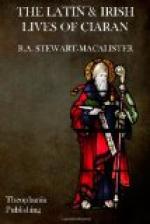The two versions are independent. But though there are no wizards or druids in the VG version, they appear in another story connecting Diarmait with the foundation of Clonmacnois. This is to the effect that Diarmait was at a place on the Shannon near Clonmacnois, called Snam da En, and saw the glow of the first camp-fire lighted on the site of the future monastery by Ciaran and his followers. The druids who were with Diarmait told him that unless that fire were forthwith quenched, it would never be put out. “It shall be quenched immediately,” said Diarmait; so with hostile purpose he advanced on Clonmacnois, but instead of doing what he proposed, he suffered himself to be pressed into the service of the builders, as the story in VG narrates. The tale in LA is interesting, as showing (1) the existence of a calendar of seasons lucky and unlucky for various enterprises, and (2) a spirit of kindly tolerance on the part of the pagan wizard.
The wiles of wizards were exposed by various saints, e.g. by Aed and by Cainnech. These tales are curious; the wizard in each case appeared to pass through a tree, but the saint opened the eyes of the spectators, so that they saw him actually passing round it (CS, 353, 368; VSH, i, 156). This reads like the exposure of hypnotically induced hallucinations.[24]
Diarmait mac Cerrbeil, or more properly mac Fergusa Cerrbeil, was grandson of Conall Cremthainne, son of Niall Noi-giallach, the ancestor of the royal line of Ui Neill. The reigning king, Tuathal Moel-Garb, of whom we have already heard, was grandson of Coirpre, another son of Niall. As a possible rival for the kingship, Tuathal had driven him into banishment. Mael-Moire, or Mael-Morda, who murdered Tuathal, was Diarmait’s foster-brother. When Diarmait was installed on the throne, he summoned the convention of Uisnech—one of the places where from time immemorial religious Pan-Iernean assemblies, resembling in character the Pan-Hellenic Olympic gatherings, had been held. How Diarmait afterwards offended Ciaran, was cursed by him, and met his death in consequence of that curse, may be read in the tale printed in Silua Gadelica, No. vi, from which we have just quoted the version of the story of setting up of the corner-post.
There are chronological discrepancies, difficult if not impossible to reconcile, between the annalist’s dates for Diarmait and those for Ciaran. The Annals of Ulster places the death of Tuathal in 543, the accession of Diarmait in 544, and the death of Ciaran in 548, seven years after founding Clonmacnois. Some MSS. of these Annals, however, omit the reference to the seven years, and place the accession of Diarmait in 548, evidently to reconcile the stories. According to the Annals of the Four Masters, Tuathal was slain in 538, Diarmait succeeded in 539, and Ciaran died in 548. The Annals of Clonmacnois is more consonant with the chronology of the Life of Ciaran. It tells the tale so picturesquely that we transcribe it here, as before modernising the spelling—




